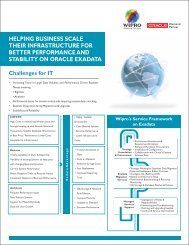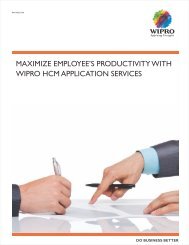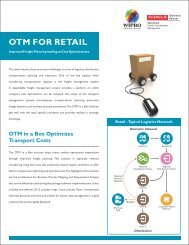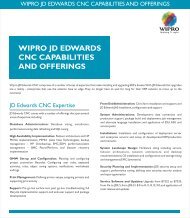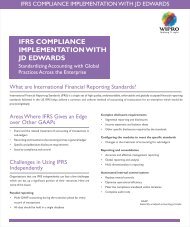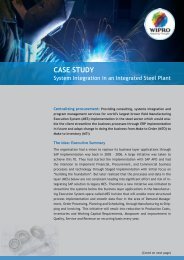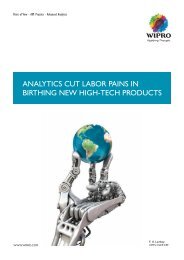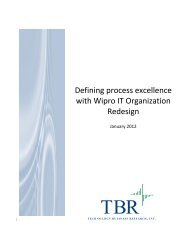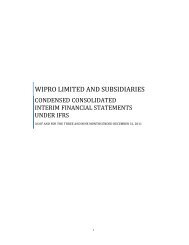Exploring the Supply Chain
Exploring the Supply Chain
Exploring the Supply Chain
You also want an ePaper? Increase the reach of your titles
YUMPU automatically turns print PDFs into web optimized ePapers that Google loves.
<strong>Exploring</strong> <strong>the</strong><br />
Green<br />
<strong>Supply</strong> <strong>Chain</strong><br />
WWW.WIPRO.COM | 1
Table of Contents<br />
Introduction..…………………………………………………………………………………………………………………..……..3<br />
Green initiatives are central to organizations' overall business objectives ……………………………..4<br />
Organizations have implemented <strong>the</strong> green supply chain both internally and externally for<br />
myriad uses…………………………………………………………………………………………………………………………….6<br />
Prioritization and cost/budget constraints are daunting barriers to implementing a green<br />
supply chain model ………………………………………………………………………………………………………………..7<br />
The environmental factor of <strong>the</strong> green supply chain is very important to organizations ….…….8<br />
Organizations believe that reducing <strong>the</strong> environmental impacts related to <strong>the</strong> IT asset lifecycle<br />
is <strong>the</strong> single most important benefit of a green supply chain.…………….……………………………...……9<br />
Conclusion…………….……………………………………………………………………………………………………………...10<br />
WWW.WIPRO.COM | 2
Introduction<br />
Whe<strong>the</strong>r or not you’re personally feeling <strong>the</strong> effects of global warming in your daily life, it’s clear that<br />
our planet is facing some grave issues. Resources are becoming scarce, areas that were once wooded<br />
now have fallen victim to deforestation, animal species are disappearing at an alarming rate as <strong>the</strong>ir<br />
native habitats are destroyed, air and water quality is questionable and <strong>the</strong> overall temperature of our<br />
planet is soaring at an astounding rate -- negatively impacting people, places and things. We are in <strong>the</strong><br />
midst of a climate crisis.<br />
Individuals are increasingly becoming not only aware of environmental concerns, but <strong>the</strong>y are also<br />
becoming active participants in saving <strong>the</strong> planet. Individuals are taking large and small steps to<br />
minimize <strong>the</strong>ir carbon footprint, like driving more efficient cars, using earth-friendly products or shutting<br />
off lights when <strong>the</strong>y are not needed. And increasingly, consumers are identifying and choosing to do<br />
business with companies of all types that are ecologically aware and environmentally friendly.<br />
Going green is no longer simply a buzzword. It’s a strategy that can lead to considerable gains in<br />
efficiencies, competitive advantage and in your bottom line – as well as <strong>the</strong> obvious savings in resources<br />
and energy. Technology is an enabler of green supply chain management.<br />
It’s not enough to simply reduce <strong>the</strong> energy you use. Organizations must reduce carbon emissions across<br />
<strong>the</strong> supply chain. All organizational activities have some direct or indirect impact on <strong>the</strong> firm’s carbon<br />
efficiency. And that’s where green supply chain management comes into play.<br />
A green supply chain is one with minimal environmental impact. It is a supply chain that encompasses<br />
best practices in reducing carbon emissions across <strong>the</strong> supply chain, from materials sourcing through<br />
product design, manufacturing, distribution, delivery and finally, end-of-life recycling. Typical supply<br />
chain management requires organizations to optimize various metrics ranging from costs, levels of<br />
service, inventory levels and more. A green supply chain includes <strong>the</strong> additional carbon emissions<br />
metric, which significantly changes <strong>the</strong> mix. Organizations that pursue a green model of business must<br />
be mindful of CO2 emissions in <strong>the</strong>ir operations.<br />
Outsourcing Center and Wipro performed a survey that examined <strong>the</strong> attitudes and approaches to<br />
green supply chain management of organizations across various industry segments. Although <strong>the</strong> survey<br />
results do not represent a complete view of how all organizations view green supply chain management,<br />
<strong>the</strong>y do successfully point to some general trends and views on this important and relevant topic. Survey<br />
respondents were from retail, financial services, transportation/logistics, manufacturing, healthcare,<br />
telecommunications and o<strong>the</strong>r industries.<br />
How is your organization approaching green supply chain management?<br />
WWW.WIPRO.COM | 3
Green initiatives are central to organizations’ overall business<br />
objectives.<br />
WWW.WIPRO.COM | 4<br />
Are green initiatives central to your overall business objectives?<br />
No<br />
27%<br />
In <strong>the</strong> post-recession economy, businesses must run lean, do more with less and hold costs down. A<br />
green strategy can go a long way in helping firms meet today’s goals and objectives. Green initiatives<br />
can reach into every area of an organization, from marketing to manufacturing to distribution. Green<br />
initiatives can help firms cut costs since <strong>the</strong>y lead to more efficient use of resources and operating<br />
efficiencies as well. It’s no wonder that 73.2 percent of those responding to <strong>the</strong> Wipro-Outsourcing<br />
Center survey indicated that green initiatives are central to <strong>the</strong>ir overall business objectives.<br />
“At Wipro, we believe that sustainability presents one of <strong>the</strong> biggest opportunities of <strong>the</strong> 21st century<br />
and will be <strong>the</strong> next avenue for organizations seeking to build competitive advantage,” said Rajeshwar<br />
Dayal Mitra, Wipro’s Practice Head of <strong>Supply</strong> <strong>Chain</strong> & Sustainability Practice, EAS.<br />
Organizations that have already made green initiatives part of <strong>the</strong>ir overall business strategy are getting<br />
<strong>the</strong> message: being environmentally conscious is a win-win for business and <strong>the</strong> environment. Although<br />
implementing a “green” program generally requires some initial investment, <strong>the</strong> payoffs can be<br />
substantial. Going green – adopting principles and practices that reduce your overall impact on <strong>the</strong><br />
environment – is good for business in several ways.<br />
Cut costs. First, adopting green principles and practices like reducing energy consumption, recycling and<br />
utilizing sustainable resources when possible can result in dramatic cost savings and operational<br />
efficiencies. Simply cutting energy usage can save money, but getting creative with green strategies can<br />
transform your business into one that’s not only kinder to <strong>the</strong> firm’s budget but to our planet as well.<br />
73%<br />
Yes
Examples from different industries include:<br />
• UPS now uses rail transport extensively to gain significant carbon reductions. In 2008 alone,<br />
ground-to-rail shifts prevented absolute emissions of 1 million metric tons of CO2 in <strong>the</strong> firm’s<br />
U.S. package operations.<br />
• TD Bank invests heavily in going green, buying wind, solar and o<strong>the</strong>r renewable energy sources<br />
worth 31,000 tons in carbon offsets. Its prototype “green” branch, <strong>the</strong> first of 10 scheduled or<br />
under construction, strives to reduce energy consumption by 50 percent over traditional bank<br />
branches and will generate up to 20 percent of <strong>the</strong>ir own electricity through solar panels on <strong>the</strong><br />
buildings’ roofs.<br />
• BMW of North America LLC’s two regional distribution centers in suburban Chicago and Eastern<br />
Pennsylvania received Leadership in Energy and Environment Design (LEED) certifications from<br />
<strong>the</strong> U.S. Green Building Council. The firm reduced its facilities’ energy and water usage by more<br />
than 20 percent from standard buildings, and <strong>the</strong> company recycles or o<strong>the</strong>rwise diverts from<br />
landfills more than 80 percent of all construction waste.<br />
Meet regulations. Secondly, going green can help firms comply with various regulatory requirements.<br />
The Environmental Protection Agency keeps close tabs on organizations’ activities that have <strong>the</strong><br />
potential of harming land, water or air. Around <strong>the</strong> world, nations are enacting laws that require<br />
businesses to adopt environmentally responsible manufacturing processes and procedures intended to<br />
cut both carbon emissions and reduce greenhouse gases. As with o<strong>the</strong>r regulations, failure to comply<br />
with <strong>the</strong>se can be costly for an organization, in dollars as well as in terms of reputational damage.<br />
“Leading U.S. Investors recently announced that <strong>the</strong>y have filed a record 95 climate change-related<br />
shareholder resolutions with 82 U.S. and Canadian companies that face far-reaching business<br />
challenges from climate change,” says Ceres, a leading coalition of investors, environmental groups and<br />
o<strong>the</strong>r public interest groups working with companies to address sustainability challenges such as global<br />
climate change. According to Ceres, <strong>the</strong> 40 percent increase in <strong>the</strong>se resolutions filed over this past<br />
year is a first sign of <strong>the</strong> growing pressure on companies to disclose climate risks and opportunities in<br />
<strong>the</strong> wake of <strong>the</strong> recent Securities and Exchange Commission’s climate disclosure guidance and o<strong>the</strong>r<br />
recent policy developments.<br />
Added Anand Chatterjee, Wipro’s Head of Center of Excellence for Sustainability, SCM & SRM, “The<br />
first wave of sustainability software is driven by reporting and regulatory requirements.”<br />
Use resources effectively. Third, innovative models can drive organizational efficiencies of all kinds.<br />
Enterprises can implement software models like Software-as-a-Service (SaaS) that reduces energy<br />
usage while also requiring less onsite equipment.<br />
Demonstrate good corporate citizenship. Fourth, companies that implement green policies and<br />
procedures in <strong>the</strong>ir organizations establish <strong>the</strong>mselves as energy-conscious and environmentallyaware.<br />
Individuals are becoming increasingly aware of and savvy about environmental concerns. This<br />
ever-expanding group is much more likely to opt to do business with organizations that embrace<br />
sustainability and employ green principles in all facets of <strong>the</strong>ir business. And <strong>the</strong> companies that get it<br />
right can have a significant competitive advantage over those that don’t.<br />
WWW.WIPRO.COM | 5
Organizations have implemented <strong>the</strong> green supply chain both<br />
internally and externally for myriad uses.<br />
WWW.WIPRO.COM | 6<br />
What is <strong>the</strong> scope of green supply chain internally and externally in<br />
your organization?<br />
Internal Scope:<br />
videoconferencing,<br />
building automation,<br />
supply chain software,<br />
and carbon<br />
management suites<br />
22%<br />
O<strong>the</strong>r<br />
11%<br />
32%<br />
35%<br />
External Scope: from design and<br />
manufacture through operation<br />
and final disposal<br />
Internal Scope: improve<br />
supply chain operational<br />
consistency<br />
According to an article in The Coastal Business Journal, Spring 2009: Volume 8, Number 1,<br />
“Opportunities in Green <strong>Supply</strong> <strong>Chain</strong> Management,” <strong>the</strong> traditional supply chain comprises five parts:<br />
raw material, industry, distribution, consumer and waste. Each of <strong>the</strong> links in <strong>the</strong> supply chain can be a<br />
reason for pollution, waste and o<strong>the</strong>r hazards to <strong>the</strong> environment. A company may use environmentally<br />
harmful raw materials such as lead. However, organizations can put pressures on suppliers to use more<br />
environmentally-friendly materials and processes.<br />
An integral part of sustainability initiatives at global organizations is <strong>the</strong> close examination of <strong>the</strong>ir<br />
supply chain environmental footprints.<br />
“Some companies have embarked on fragmented initiatives to minimize <strong>the</strong>ir transportation carbon<br />
footprint or make <strong>the</strong>ir manufacturing plants more eco-friendly,” said Noha Tohamy, Vice President,<br />
<strong>Supply</strong> <strong>Chain</strong> Research, AMR Research. “But greening <strong>the</strong> supply chain must be founded on coherent<br />
strategies that examine <strong>the</strong> tradeoffs between environmental initiatives, profitability and efficiency<br />
across <strong>the</strong> integrated supply chain.”<br />
According to <strong>the</strong> Wipro-Outsourcing Center survey, holding down costs is not <strong>the</strong> most common focus<br />
for organizations’ green supply chain initiatives for 2010. More than a third of companies reported that<br />
<strong>the</strong>ir green supply chain initiatives were focused most on <strong>the</strong> environmental concerns. In contrast, only<br />
14.7 percent of participants said that <strong>the</strong> cost advantage of <strong>the</strong>ir green supply chain initiatives was <strong>the</strong>ir
key focus. However, 29.4 percent of respondents said that lowering IT operating expenses and capital<br />
costs is <strong>the</strong>ir focus for a green supply chain initiative this year.<br />
When asked about <strong>the</strong> scope of <strong>the</strong>ir organization’s green supply chain initiative, survey respondents<br />
were somewhat divided in terms of <strong>the</strong>ir focus.<br />
• More than a third (35.1%) of respondents said that <strong>the</strong>ir internal scope was to improve supply chain<br />
operational consistency.<br />
• Just less than a third of participants (32.4%) said that <strong>the</strong> external scope of <strong>the</strong>ir green supply chain<br />
reaches from design and manufacture through operation and final disposal.<br />
• Just less than a quarter (21.6%) of survey respondents said that <strong>the</strong>ir internal green supply chain scope<br />
included videoconferencing, building automation chain software, and carbon management suites.<br />
“Going forward, sustainability will become <strong>the</strong> key driving <strong>the</strong>me for supply chain cost optimization,<br />
which today is primarily driven by profit maximization objectives,” said Samir Shukla, Wipro’s Senior<br />
Portfolio Manager for <strong>Supply</strong> <strong>Chain</strong> Practice, EAS.<br />
Prioritization and cost/budget constraints are daunting<br />
barriers to implementing a green supply chain model.<br />
WWW.WIPRO.COM | 7<br />
What do you believe to be <strong>the</strong> crucial barriers to implementing a<br />
green supply chain model?<br />
65%<br />
62%<br />
Prioritization Cost/Budget<br />
constraints<br />
14%<br />
22%<br />
Security risks O<strong>the</strong>r<br />
Although reasons for employing a green supply chain initiative can range from chiefly altruistic to a<br />
pressing need to hold down costs, <strong>the</strong> barriers to employing such a model can be daunting. A green<br />
supply chain can touch virtually every activity and every process and every person in an organization.
Its reach is far and wide and so are its potential benefits. Unfortunately, <strong>the</strong> greater <strong>the</strong> benefit and<br />
wider <strong>the</strong> scope of a green supply chain, <strong>the</strong> more challenging it can be to implement.<br />
Nearly two-thirds (64.9%) of survey respondents indicated that prioritization was a crucial barrier to<br />
implement a green supply chain model, and 62.2 percent cited cost/budget constraints as an<br />
intimidating barrier. Only 13.5 percent felt security risks were substantial enough to be considered a<br />
crucial barrier to implementing a green supply chain model.<br />
Prioritizing projects is one of <strong>the</strong> greatest barriers to implementing a green supply chain, according to<br />
<strong>the</strong> survey respondents. It’s difficult to decide which potential opportunities and activities to consider,<br />
and in what order. To prioritize potential opportunities, companies must evaluate and re-evaluate <strong>the</strong><br />
ROI for each initiative. Organizations should consider all potential green initiatives toge<strong>the</strong>r as a whole,<br />
since each initiative may not have a positive ROI, but <strong>the</strong> net result of all initiatives toge<strong>the</strong>r might be<br />
well worth <strong>the</strong> effort, both in terms of investment and in o<strong>the</strong>r and often less-tangible benefits.<br />
Implementing a green supply chain model can be a Herculean effort, one that many enterprises may<br />
find too difficult to approach on <strong>the</strong>ir own. These companies might be well-advised to tap <strong>the</strong> expertise<br />
of outside consultants and vendors that have helped o<strong>the</strong>r firms successfully transform <strong>the</strong>ir supply<br />
chain, creating green/sustainable practices and processes across <strong>the</strong> organization with proven best<br />
practices.<br />
The environmental factor of a green supply chain is very<br />
important to organizations.<br />
WWW.WIPRO.COM | 8<br />
In your opinion, how important is <strong>the</strong> environmental factor of a green<br />
supply chain?<br />
5% 3%3%<br />
Somewhat unimportant<br />
Nei<strong>the</strong>r important<br />
Not at all important<br />
nor unimportant<br />
Somewhat<br />
important<br />
28%<br />
61%<br />
Very important<br />
Sustainability and environmental considerations are both key to a green supply chain, but <strong>the</strong>re are<br />
many o<strong>the</strong>r reasons for and benefits of implementing such a model. Gaining efficiencies of all kinds,
meeting regulatory compliance, reducing costs and boosting shareholder value are all considerations.<br />
However, a large majority (89.7%) of survey respondents said that <strong>the</strong> environmental factor of a green<br />
supply chain is ei<strong>the</strong>r somewhat important or very important. Only 5.2 percent believe <strong>the</strong><br />
environmental earth-saving benefits are ei<strong>the</strong>r somewhat unimportant or not at all important.<br />
While it’s admirable that companies choose to implement green/sustainability initiatives within <strong>the</strong>ir<br />
firm, it’s important that <strong>the</strong>se organizations take extensive measures throughout <strong>the</strong>ir organization and<br />
in every link in <strong>the</strong>ir supply chain. Simply labeling your organization as energy conscious by taking<br />
minimal action to become more earth-friendly is not effectively going green. Businesses can’t strive to<br />
become more energy efficient by merely buying new light bulbs or cutting energy usage. Instead, for an<br />
organization to be truly “green” requires a consistent effort from every area of <strong>the</strong> firm. The most<br />
energy-efficient companies are those in which <strong>the</strong> energy-saving message is part of <strong>the</strong> corporate<br />
culture. Transforming a supply chain into one that is environmentally friendly or “green” requires buyin<br />
from everyone within an organization and must include engaging with all stakeholders, including<br />
investors, clients, suppliers and employees.<br />
By and large, <strong>the</strong> voluntary introduction of industry standards seems to be <strong>the</strong> most common model of<br />
enforcing suppliers’ commitment to sustainable practices. As businesses globalize and supply chains<br />
grow, however, it remains to be seen whe<strong>the</strong>r such arrangements will be able to cope with <strong>the</strong><br />
increased levels of complexity and diversity.<br />
Organizations believe that reducing <strong>the</strong> environmental<br />
impacts related to <strong>the</strong> IT asset lifecycle is <strong>the</strong> single most<br />
important benefit of a green supply chain.<br />
WWW.WIPRO.COM | 9<br />
What are <strong>the</strong> greatest benefits of a green supply chain?<br />
Customer Preference:<br />
Enhancing reputation<br />
among stakeholders/<br />
competitors<br />
24%<br />
O<strong>the</strong>r<br />
8%<br />
29%<br />
Business Benefits:<br />
Cost reduction<br />
39%<br />
Environmental Benefits:<br />
Reducing <strong>the</strong><br />
environmental impacts<br />
related to <strong>the</strong> IT asset<br />
lifecycle
While <strong>the</strong> environmental factor proved to be important to a great majority of survey respondents, <strong>the</strong><br />
participants differed in <strong>the</strong>ir choice of <strong>the</strong> greatest benefits of a green supply chain.<br />
• The largest percentage of respondents (39.5%) believed that <strong>the</strong> greatest benefit of a green<br />
supply chain is <strong>the</strong> “Environmental Benefits: Reducing <strong>the</strong> environmental impacts related to <strong>the</strong><br />
IT asset lifecycle.”<br />
• Ano<strong>the</strong>r 28.9 percent identified “Business Benefits: Cost reduction” as <strong>the</strong> greatest benefit of<br />
such a model.<br />
• Nearly a quarter (23.7%) said that <strong>the</strong> greatest benefit of a green supply chain is “Customer<br />
Preference: Enhancing reputation among stakeholders/competitors.”<br />
While going green benefits <strong>the</strong> environment, it doesn’t automatically translate into good business.<br />
However, a green supply chain can certainly lead to cost reductions and ultimately to meeting<br />
customers’ increasing preference for ecologically-friendly goods and services. While an environmentallyfriendly<br />
supply chain can be initially more expensive, <strong>the</strong>re are cost savings to be had by cutting back on<br />
energy and o<strong>the</strong>r resources used and in reducing <strong>the</strong> firm’s carbon footprint. And <strong>the</strong>re’s mounting<br />
evidence that customers look favorably on companies that are concerned about <strong>the</strong>ir carbon footprint.<br />
Companies shouldn’t underestimate <strong>the</strong> power of environmentally-conscious consumers. In June 2009,<br />
marketing firm BBMG performed a survey and discovered that more than three-fourths of consumers<br />
(77%) revealed that <strong>the</strong>y can “make a positive difference by purchasing products from socially or<br />
environmentally responsible companies.” And 72 percent of those responding said that <strong>the</strong>y’ve<br />
“avoided purchasing products from companies whose practices <strong>the</strong>y disagree with.” Additionally, a<br />
majority of customers are willing to pay more for environmentally-friendly or sustainable goods and<br />
services.<br />
“Now investments in <strong>the</strong> green supply chain are no more a branding activity,” said Rajesh Acharya,<br />
Wipro’s Practice Manager for Sustainability Solutions (America). “They are investments that have a<br />
positive net present value (NPV).”<br />
Conclusion:<br />
The benefits of going green are substantial. A green supply chain can not only reduce an organization’s<br />
carbon footprint but also lead to reduced costs, improved reputation with customers, investors and<br />
o<strong>the</strong>r stakeholders – and a competitive edge in your market. And that’s good business.<br />
To be sure, <strong>the</strong>re are some daunting roadblocks for organizations looking to implement green<br />
initiatives in <strong>the</strong>ir firms. A solid business case is essential, as are a detailed implementation roadmap<br />
and a strategy for resolving governance and compliance issues and assessing security risks.<br />
Prioritization is an issue for many companies, as are budget constraints. While <strong>the</strong>se can be daunting<br />
barriers to implementing a green supply chain model, <strong>the</strong>y do not have to prevent organizations from<br />
adopting this clearly beneficial model.<br />
Wipro can help organizations with every phase of green supply chain management.<br />
WWW.WIPRO.COM | 10
About <strong>the</strong> Survey Respondents:<br />
A full 42.6 percent of survey participants are employed at firms with more than 20,000 employees.<br />
Approximately a third (33.8%) work for relatively small firms with fewer than 500 employees. The<br />
remaining 23.6 percent said <strong>the</strong>ir firms employed more than 1,000 individuals but fewer than 20,000<br />
people. Half of respondents said <strong>the</strong>ir company’s annual revenue is greater than $500 million, while<br />
nearly a third (31.4%) of participants said <strong>the</strong>ir firm’s annual revenue is less than $20 million. More<br />
than half (52.9%) of survey participants responded that <strong>the</strong>ir IT budget for 2010 is more than $10<br />
million, and <strong>the</strong> remaining 47.1 reporting <strong>the</strong>ir budgets at below <strong>the</strong> $9 billion mark for <strong>the</strong> year.<br />
ABOUT WIPRO TECHNOLOGIES<br />
Wipro is <strong>the</strong> first PCMM Level 5 and SEI CMMi Level 5 certified IT Services Company globally. Wipro<br />
provides comprehensive IT solutions and services (including systems integration, IS outsourcing,<br />
package implementation, software application development and maintenance) and Research &<br />
Development services (hardware and software design, development and implementation) to<br />
corporations globally.<br />
Wipro's unique value proposition is fur<strong>the</strong>r delivered through its pioneering Offshore Outsourcing<br />
Model and stringent Quality Processes of SEI and Six Sigma.<br />
ABOUT WIPRO Council for Industry Research<br />
The Wipro Council for Industry Research comprising of domain and technology experts from <strong>the</strong><br />
organization aims to address <strong>the</strong> needs of customers by specifically looking at innovative strategies that<br />
will help <strong>the</strong>m gain competitive advantage in <strong>the</strong> market. The Council, in collaboration with leading<br />
academic institutions and industry bodies, studies market trends to equip organizations with insights<br />
that facilitate <strong>the</strong>ir IT and business strategies.<br />
For more information, please visit www.wipro.com/industryresearch.<br />
ABOUT OUTSOURCING CENTER<br />
Outsourcing Center is <strong>the</strong> most prominent Internet portal for thought leadership, best practices,<br />
emerging trends, and strategies for successful sourcing. In addition, since 1997 we have recognized <strong>the</strong><br />
world’s best outsourcing relationships through <strong>the</strong> annual Outsourcing Excellence Awards program. As<br />
<strong>the</strong> resource for actionable business insights, Outsourcing Center provides objective perspectives and<br />
real-world examples, identifies business risks, and explains how to leverage value-creation<br />
opportunities. More than 94 percent of <strong>the</strong> Fortune 500 companies, along with midsized and small<br />
businesses, visit our site. The Center’s parent company is Everest Group, an advisor to business leaders<br />
on global services with a worldwide reputation for helping Global 1000 firms dramatically improve <strong>the</strong>ir<br />
performance by optimizing <strong>the</strong>ir back- and middle-office business services.<br />
For more information, please visit www.outsourcing-center.com.<br />
WWW.WIPRO.COM | 11





